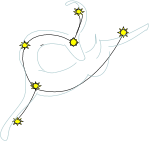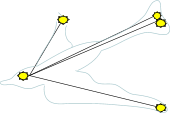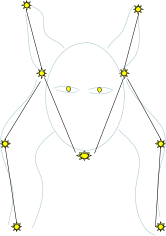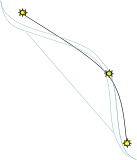Togruta Culture
Pack Mentality
Togruta had a strong sense of unity and togetherness, as was required to stand up against the dangerous animals that hunted them, like the Akul. While most of Shili was covered in the scrublands where the Togruta hunted their herbivorous prey, the Togruta lived in small communities in the forest valleys, where the canopies kept them out of sight. These villages were usually integrated with civil city life and technology, but the level of integration could easily vary from tribe to tribe, some being far too remote to be troubled with modern conveniences.
In the pack, every able Togruta was expected to contribute his or her own share, as any food attained was distributed equally. A pack-dwelling Togruta was trained to hunt from the time they could walk, through play, and simple weapons training began as early as age 5 or 6 with bow and spear and sling. As hunters, the Togruta showed off the pelts and teeth of their game as a sign of pride and maturation. Special pride was taken in the teeth of akul that a Togruta had taken down as an individual. These teeth often were made into jewelry such as an akul-tooth headdress or a necklace, which also incorporated metals, stones, and pearls found on Shili.
Togruta were tranquil and silent, though when the situation called for it they were true warriors. Their fidelity to their beliefs was legendary, as was their happiness within large groups. Togruta, not surprisingly, excelled at teamwork and the ability to associate with different cultures. To an extent, Togruta had an aversion to isolation and made efforts to have friends around for companionship. Those within a pack who led had a difficult time with fulfilling their goals because of the risk of becoming individualistic. The character traits of jealousy and greed were counterproductive to community survival and those who displayed them were oft disparaged and shunned. The concept of “mine” was especially foreign to tribal communities far away from the city hubs of outside influence, which could make assimilation of new culture difficult if ever placed in such a situation.
Religion
Togruta were known for their habit of not wearing shoes; they believed that the land was spiritually connected to them, and wearing shoes cut themselves from a bond with the land. This intense awareness of and respect for the life around them could be misconstrued as something more. Although Togruta’s connectivity to their environment gave them a special affinity for ‘the Force’ as a whole, they had slightly less than the normal number of midichlorians. While sensitive, vulnerable to it, not all Togruta had the ability to manipulate this life Force. The species had contributed members to the Jedi Order almost since its beginning, though, and most of those who did were female.
Perhaps contradictory to the Jedi mentality, Togruta were also known for their belief that those who could not keep up should be left to fend for themselves, because that is nature's way. It is for this reason that in pack-oriented communities, the age demographic consists largely of young-middle adults. There are few old people and infant-young children mortality rates are high. Other sentient species found this particular belief quite barbaric.
When a Togruta is left behind, they are gifted with a few tokens to ensure a safe journey to the spirit world – some food, water, and are permitted to keep their weapons. Usually a small carving or two is included in the afterlife care package – effigies to guide their souls. In the event that their wounds or illness does not kill them directly, abandoned Togruta tend to fall prey to severe depression, the elements, and predators. In the rarer event that they survive the separation and restore their strength, they may rejoin the pack and are sometimes feared or celebrated as being restored to life.
When a Togruta dies a natural death, their body is burned along with these gifts, then skeletal remains are buried in a sacred site – often a cave or tunneled system that leads to “Shili’s womb”. Only a select few members of the pack – the pack leader, the spiritual leader, and maybe an apprentice are permitted to carry the bones inside. It is one of the few duties that mark them as individuals of importance apart from the rest of the pack.
Storytelling is an important means of teaching important life lessons and core beliefs within the pack. Such stories are passed down from one spiritual leader to another, though many pack members who pay attention will have memorized the gist of the stories by the time they’ve reached adulthood. There is often some degree of ceremony that accompanies the telling of a story, sometimes as exuberant as involving music and dance.
Astrology and Astronomy
The Togruta specie is relatively new to roaming the stars, having only just been discovered by more advanced civilizations around 25,000 BBY. Since the dawn of their existence, however, the Togruta people have still relied upon celestial signs to track the changing of seasons, migration of herds, and other spiritually significant events. Over the many ages to pass, those who cast a curious and discerning eye to the sky have come to name - and rename - countless constellations.
Here are a few:
Djeba dahk'uba - kicking djebaThe djeba is a diurnal creature and one of the three “sa’daar” who, as legend tells it, pleaded with the hunter to kill the moon so that the sun may forever shine. Because of their towering size, the sparse herds of djeba are not frequently hunted. A butchered djeba can feed a large pack for weeks and provide copious materials with its bone, skin, and sinew.
Kee’tch is a revered species, or rather family, of birds that reside both in the dense forest and few trees scattered about the grasslands. They are small, often colorful, and with thin, trailing tail feathers. Their name stems from their habit of ‘attending’ Togruta funerary pyres, often while the flames still sputter, to snatch bits of charred twigs and debris to add to their nest. This peculiar behavior is explained by scientists as being an innovative way to help cleanse their nests of mites and other pests by tossing around the warm soot. To the native Togruta, however, this behavior possess an element of magic, in that the birds manage to not set their nests afire and believe their visitation is intended to guide the spirit of the deceased to follow them into the sky. To hunt a kee’tch is taboo and great insult to Shili’neh, although other resident fowl are fair game.
More specifically, one of the first ancestors - the hunter who was selfishly enticed by his brothers, djeba, trrre, and taztuk’a’a, to slay the moon and force his mate, the sun, to be forever awake. According to the legend, the hunter swiftly came to regret his decision when all the waters dried up and life began to wither away. As means to repent for his sin, he begged the enraged sun to take all his breaths and give them to the moon so that the moon may be revived and balance restored. His request was granted and so the hunter left corporeal existence to resuscitate his wronged co-creator.
One of the first weapons a child learns to use, in traditional pack life. There are many types of arrows to master, each specialized to most effectively kill different prey, or predators. The hunter in the legend of how Togruta earned their stripes used his bow to shoot down the moon, a mistake that nearly destroyed life on his mother planet.
One who crawls on belly, the serpent is a creature that native Togruta are wary of. The name is used to identify multiple species of animal - snakes, eels, and a few other nefarious, aquatic creatures - but for those with inherent knowledge of their ecology, the context in which it’s spoken usually can clarify /which/ togn’a ki the speaker refers to. Togn’a ki is the reason pack-dwelling Togruta children are warned to keep out of the water and the reason the weekly trips to the river or stream for washing are a communal event. It is not unheard of for small or weak Togruta to disappear from the water’s edge, and some tog’na ki grow large enough to consume younglings and mutilate or crush adults. Smaller, land-dwelling tog’na ki often possess a venomous bite that is capable of inflicting death. They are usually either given a respected berth in the field or killed outright for slithering too near camp.
Pack Structure
Pack leader selected from the tribe once the old one dies. This role is not necessarily inherited, and while traditionally undertaken by a male, there have been a few females throughout the course of their history that have fulfilled this role. The pack leader faces a difficult life, having to juggle uniformity and oneness with the people, with the independent thinking and decision making that is sometimes necessary to make a judgment call on behalf of the pack. There’s a lot of responsibility riding on their shoulders, to say the least.
Spiritual Leader:
The spiritual leader, or Y’grritii, is responsible for keeping the pack connected to and in favor of the spirit of Shili. They, above all, are in tune with the natural world and, as they believe, the supernatural. This role is traditionally filled by females, but male shamanic figures have held station over the course of their history.
When a new spiritual leader is named, following the death or impending death of their predecessor, they discard their given name and adopt Y’grritii as both name and title. As Y’gritii ages, they will select an apprentice to teach the secrets to and train them to be in service to the bond between Shili and her people.
In a village, they live in a single dwelling, either alone or with a companion. One of their special instruments of the trade is the ‘spirit horn’, which is the severed montral of their predecessor. The belief is that the Y’grritii may commune with the spirit world, the soul of Shili herself, through this horn, which contains the memories and knowledge and spiritual relationships of all Y’grritii gone before. The ghostly moan that resonates from the horn when air is breathed into it creates the illusion that the spirits of the ancestors, all prior Y'grritii, are speaking, having been given a voice by the living.
When Y’grritii dies, one of their montrals is broken from their skull, ritually cleansed, and replaces the ‘spirit horn’ previously used, with the understanding that it contains the recently deceased’s memories and wisdom, which in turn includes the knowledge of all thousands of generations gone before. In essence, they ‘refresh’ the memory of the collective by retrieving this gruesome artifact from each Y’grritii that dies and respectfully burying the discarded one formally used.
Everyone Else: That’s it. When it comes to eating, sleeping, everyone else in the pack is on equal ground and opportunity. Younglings are usually fed first though, during meal times, after the Pack Leader and Y’grritii.




